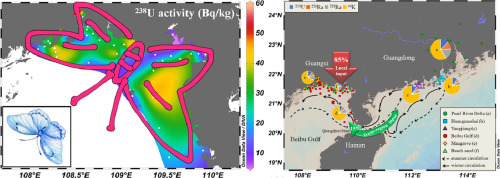Marine Geology ( IF 2.6 ) Pub Date : 2020-02-25 , DOI: 10.1016/j.margeo.2020.106157 Wuhui Lin , Yu Feng , Kefu Yu , Wenlu Lan , Yinghui Wang , Zhenni Mo , Qiuyun Ning , Liangliang Feng , Xianwen He , Yinlin Huang

|
The source and transport process of sediments are of great concern in marine sedimentology. In this study, naturally occurring radionuclides (238U, 226Ra, 228Ra, and 40K) in surface sediments and sediment cores were comprehensively analysed using high-purity germanium (HPGe) γ spectrometry in order to explore radionuclide fingerprints as novel proxies for tracking the source and transport pathway of sediments in the Beibu Gulf. We found that the radioactivity level of sediments in the Beibu Gulf was lower than that in other Chinese seas, following a comprehensive compilation and comparison of radioactivity in the region, indicating the Beibu Gulf is a high-quality marine environment. An interesting “butterfly pattern” was exhibited in the horizontal distribution of radionuclides in surface sediments from the Beibu Gulf, mainly attributable to the controlling factors of the non-linear negative regulation of sediment grain size and positive role of total organic carbon in sediment. Furthermore, the vertical distribution of radionuclides in sediment cores was affected by the redox state and a physical/biological disturbance, which were demonstrated by the simultaneous analysis of redox-sensitive element Mn and 210Pb, respectively. Additionally, the 226Ra 238U endmember model and 232Th
238U endmember model and 232Th 238U endmember model were proposed for quantifying local input (85%) and trans-region input (15%) of marine sediments in the Beibu Gulf in the context of the Guangdong-Qiongzhou Strait-Guangxi framework. We inferred that the Beibu Gulf was at risk of contamination by artificial radionuclides derived from nearby Guangdong Province, which has the highest number of nuclear power plants in China, through a trans-region input by ocean currents. Our study not only provided spatiotemporal distributions of radionuclides in the Beibu Gulf and their controlling factors (sediment grain size, total organic carbon, redox state, physical/biological disturbance, and ocean currents) but also indicated the radionuclide fingerprints (226Ra/238U and 232Th/238U) as potential geochemical proxies for quantifying the distinct sources of radionuclides and other associated chemicals (e.g., heavy metals, organic pollutants) in sediments.
238U endmember model were proposed for quantifying local input (85%) and trans-region input (15%) of marine sediments in the Beibu Gulf in the context of the Guangdong-Qiongzhou Strait-Guangxi framework. We inferred that the Beibu Gulf was at risk of contamination by artificial radionuclides derived from nearby Guangdong Province, which has the highest number of nuclear power plants in China, through a trans-region input by ocean currents. Our study not only provided spatiotemporal distributions of radionuclides in the Beibu Gulf and their controlling factors (sediment grain size, total organic carbon, redox state, physical/biological disturbance, and ocean currents) but also indicated the radionuclide fingerprints (226Ra/238U and 232Th/238U) as potential geochemical proxies for quantifying the distinct sources of radionuclides and other associated chemicals (e.g., heavy metals, organic pollutants) in sediments.











































 京公网安备 11010802027423号
京公网安备 11010802027423号